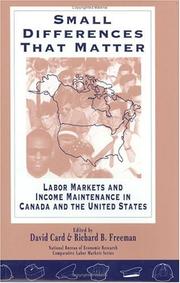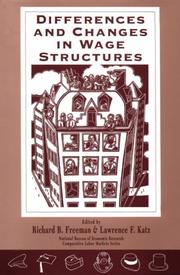| Listing 1 - 5 of 5 |
Sort by
|
Book
Year: 2017 Publisher: Washington, D.C. : The World Bank,
Abstract | Keywords | Export | Availability | Bookmark
 Loading...
Loading...Choose an application
- Reference Manager
- EndNote
- RefWorks (Direct export to RefWorks)
The Gini coefficient of labor earnings in Brazil fell by nearly a fifth between 1995 and 2012, from 0.50 to 0.41. The decline in earnings inequality was even larger by other measures, with the 90-10 percentile ratio falling by almost 40 percent. Although the conventional explanation of a falling education premium did play a role, an RIF regression-based decomposition analysis suggests that the decline in returns to potential experience was the main factor behind lower wage disparities during the period. Substantial reductions in the gender, race, informality and urban-rural wage gaps, conditional on human capital and institutional variables, also contributed to the decline. Although rising minimum wages were equalizing during 2003-2012, they had the opposite effects during 1995-2003, because of declining compliance. Over the entire period, the direct effect of minimum wages on inequality was muted.

ISBN: 0226092836 9786612004780 1282004786 0226092895 9780226092898 9780226092836 Year: 1993 Volume: *1 Publisher: Chicago : University of Chicago Press,
Abstract | Keywords | Export | Availability | Bookmark
 Loading...
Loading...Choose an application
- Reference Manager
- EndNote
- RefWorks (Direct export to RefWorks)
This volume, the first in a new series by the National Bureau of Economic Research that compares labor markets in different countries, examines social and labor market policies in Canada and the United States during the 1980's. It shows that subtle differences in unemployment compensation, unionization, immigration policies, and income maintenance programs have significantly affected economic outcomes in the two countries. For example: -Canada's social safety net, more generous than the American one, produced markedly lower poverty rates in the 1980's. -Canada saw a smaller increase in earnings inequality than the United States did, in part because of the strength of Canadian unions, which have twice the participation that U.S. unions do. -Canada's unemployment figures were much higher than those in the United States, not because the Canadian economy failed to create jobs but because a higher percentage of nonworking time was reported as unemployment. These disparities have become noteworthy as policy makers cite the experiences of the other country to support or oppose particular initiatives.
Labour market --- Wages --- Canada --- United States --- Income maintenance programs --- Labor market --- Labor market - Canada. --- Income maintenance programs - Canada. --- income maintenance, labor, markets, immigration, unemployment compensation, unionization, unions, canada, united states, social safety net, poverty, government, nonfiction, economics, earnings inequality, need, households, skill differentials, immigrant skills, international, economy, national identity, leisure, happiness, justice, ubi, wealth gap, mobility, success. --- United States of America
Book
Year: 2008 Publisher: Washington, D.C., The World Bank,
Abstract | Keywords | Export | Availability | Bookmark
 Loading...
Loading...Choose an application
- Reference Manager
- EndNote
- RefWorks (Direct export to RefWorks)
There are several possible explanations for the observed changes in inequality, the returns to education, and the gap between the wages of informal and formal salaried workers in Argentina over the period 1980-2002. Largely due to the lack of evidence for competing explanations, skill-biased technical change is the most likely explanation for the increases in the returns to education that occurred in the 1990s. Using a semi-parametric re-weighting variance decomposition technique and data from the Permanent Household Survey, the authors show that during the same period there was an increase in the returns to unobserved skill. This finding lends support to the hypothesis that skill-biased technical change has been a main driver of increases in inequality in Argentina. The pattern of changes suggests that the growth in returns to unobserved skill may have been partly responsible for the relative deterioration of informal salaried wages during the 1990s.
Access and Equity in Basic Education --- Debt Markets --- Earnings Inequality --- Education --- Education for All --- Finance and Financial Sector Development --- Household Survey --- Labor Markets --- Minimum wage --- Primary Education --- Salaried employment --- Salaried workers --- Skilled workers --- Social Protections and Labor --- Union membership --- Wage distribution --- Wage employment --- Wage inequality
Book
Year: 2008 Publisher: Washington, D.C., The World Bank,
Abstract | Keywords | Export | Availability | Bookmark
 Loading...
Loading...Choose an application
- Reference Manager
- EndNote
- RefWorks (Direct export to RefWorks)
There are several possible explanations for the observed changes in inequality, the returns to education, and the gap between the wages of informal and formal salaried workers in Argentina over the period 1980-2002. Largely due to the lack of evidence for competing explanations, skill-biased technical change is the most likely explanation for the increases in the returns to education that occurred in the 1990s. Using a semi-parametric re-weighting variance decomposition technique and data from the Permanent Household Survey, the authors show that during the same period there was an increase in the returns to unobserved skill. This finding lends support to the hypothesis that skill-biased technical change has been a main driver of increases in inequality in Argentina. The pattern of changes suggests that the growth in returns to unobserved skill may have been partly responsible for the relative deterioration of informal salaried wages during the 1990s.
Access and Equity in Basic Education --- Debt Markets --- Earnings Inequality --- Education --- Education for All --- Finance and Financial Sector Development --- Household Survey --- Labor Markets --- Minimum wage --- Primary Education --- Salaried employment --- Salaried workers --- Skilled workers --- Social Protections and Labor --- Union membership --- Wage distribution --- Wage employment --- Wage inequality

ISBN: 0226261603 9786611223434 1281223433 0226261840 9780226261843 9780226261607 Year: 1995 Volume: *2 Publisher: Chicago : University of Chicago Press,
Abstract | Keywords | Export | Availability | Bookmark
 Loading...
Loading...Choose an application
- Reference Manager
- EndNote
- RefWorks (Direct export to RefWorks)
During the past two decades, wages of skilled workers in the United States rose while those of unskilled workers fell; less-educated young men in particular have suffered unprecedented losses in real earnings. These twelve original essays explore whether this trend is unique to the United States or is part of a general growth in inequality in advanced countries. Focusing on labor market institutions and the supply and demand forces that affect wages, the papers compare patterns of earnings inequality and pay differentials in the United States, Australia, Korea, Japan, Western Europe, and the changing economies of Eastern Europe. Cross-country studies examine issues such as managerial compensation, gender differences in earnings, and the relationship of pay to regional unemployment. From this rich store of data, the contributors attribute changes in relative wages and unemployment among countries both to differences in labor market institutions and training and education systems, and to long-term shifts in supply and demand for skilled workers. These shifts are driven in part by skill-biased technological change and the growing internationalization of advanced industrial economies.
Wages --- Case studies --- Congresses --- AA / International- internationaal --- US / United States of America - USA - Verenigde Staten - Etats Unis --- 332.26 --- 338.021 --- -331.21 --- Compensation --- Departmental salaries --- Earnings --- Pay --- Remuneration --- Salaries --- Wage-fund --- Wage rates --- Working class --- Income --- Labor costs --- Compensation management --- Cost and standard of living --- Prices --- Loonevolutie. --- Theorie van de lonen. --- -Wages --- Congresses. --- -AA / International- internationaal --- Costs, Labor --- Employees --- Payroll costs --- Personnel costs --- Costs --- 331.21 --- Case studies&delete& --- Loonevolutie --- Theorie van de lonen --- Costs, Industrial --- E-books --- Wages - Case studies - Congresses --- wages, wage structures, united states of america, usa, unskilled workers, labor, work, earnings, inequality, wealth gap, markets, institutions, australia, korea, japan, europe, international studies, unemployment, gender differences, managerial compensation, training, education, case study, employment, solidarity, germany, italy, great britain, sweden.
| Listing 1 - 5 of 5 |
Sort by
|

 Search
Search Feedback
Feedback About
About Help
Help News
News